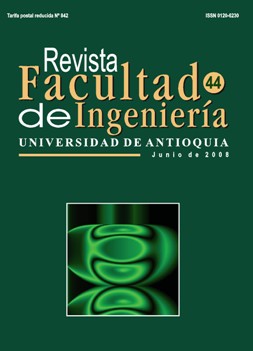Electricity price forecasting using artificial neural networks
DOI:
https://doi.org/10.17533/udea.redin.18508Keywords:
Forecasting, electricity price, artificial neural networks, time series modelsAbstract
A model for forecasting the electricity price in Colombia using artificial neural networks is proposed in this work. Two neural networks structures including the price series in the first and the price series plus the water reserve levels in the latter are used. The results are compared with a Generalized Autorregresive Conditional Heteroskedastic Model (GARCH) model, which shows better adjustment inside the training period, but the neural networks have better performance forecasting outside the training sample. Historical data was supplied by the Company XM belonging to ISA Group, where 120 days were used as training patterns and the next 31 days were left to test the next month forecast.
Downloads
References
F. J. Nogales, J. Contreras, A. Conejo, R. Espínola. “Forecasting next-day electricity prices by time series models”. IEEE Transactions on Power System. Vol. 17. 2002. pp. 342 – 348. DOI: https://doi.org/10.1109/TPWRS.2002.1007902
J. Contreras, R. Espínola, F. J. Nogales, A. Conejo. “ARIMA models to predict next-day electricity prices”. IEEE Transactions on Power Systems. Vol. 18. 2003. pp. 1014 – 1020. DOI: https://doi.org/10.1109/TPWRS.2002.804943
A. Conejo, M. A. Plazas, R. Espínola, A. B. Molina. “Day-ahead electricity price forecasting using the Wavelet transform and ARIMA models”. IEEE Transactions on Power Systems. Vol. 20. 2005. pp. 1035 – 1042. DOI: https://doi.org/10.1109/TPWRS.2005.846054
R. C. García, J. Contreras, M. V. Akkeren, J. B. C. García. “A GARCH forecasting model to predict dayahead electricity prices”. IEEE Transactions on Power Systems. Vol. 20. 2005.pp. 867 – 874. DOI: https://doi.org/10.1109/TPWRS.2005.846044
S. Haykin. “Neural networks a comprehensive foundation”. New York. Macmillan College Publishing Company.1994. 1ª ed. pp. 18 – 41.
F. Villada, W. Muñoz, A. Henao. “Pronóstico de las tasas de cambio. Una aplicación al Yen Japonés mediante redes neuronales artificiales”. Revista Scientia et Technica. Vol 12. 2006. pp. 233 – 238.
B. R. Szkuta, L. A. Sanabria, T. S. Dillon. “Electricity price short-term forecasting using artificial neural networks”. IEEE Transactions on Power Systems. Vol. 14. 1999. pp. 851 – 857. DOI: https://doi.org/10.1109/59.780895
E. Radwan. “Short term hourly load forecasting using abductive networks”. IEEE Transactions on Power Systems. Vol. 19. 2004. pp. 164 – 173. DOI: https://doi.org/10.1109/TPWRS.2003.820695
N. Amjady, M. Hemmati. “Energy price forecasting - problems and proposals for such predictions”. IEEE Power and Energy Magazine. Vol. 4. 2006. pp. 20 – 29. DOI: https://doi.org/10.1109/MPAE.2006.1597990
N. Gradojevic, J. Yang. The application of artificial neural networks to exchange rate forecasting: the role of market microstructure variables, Bank of Canada, Working paper 2000-23. 2000. pp. 10 – 27.
P. H. Franses, D. V. Dijk. Non-linear time series models in empirical finance. Cambridge University Press. 2000. pp. 222 - 233. DOI: https://doi.org/10.1017/CBO9780511754067
Downloads
Published
How to Cite
Issue
Section
License
Revista Facultad de Ingeniería, Universidad de Antioquia is licensed under the Creative Commons Attribution BY-NC-SA 4.0 license. https://creativecommons.org/licenses/by-nc-sa/4.0/deed.en
You are free to:
Share — copy and redistribute the material in any medium or format
Adapt — remix, transform, and build upon the material
Under the following terms:
Attribution — You must give appropriate credit, provide a link to the license, and indicate if changes were made. You may do so in any reasonable manner, but not in any way that suggests the licensor endorses you or your use.
NonCommercial — You may not use the material for commercial purposes.
ShareAlike — If you remix, transform, or build upon the material, you must distribute your contributions under the same license as the original.
The material published in the journal can be distributed, copied and exhibited by third parties if the respective credits are given to the journal. No commercial benefit can be obtained and derivative works must be under the same license terms as the original work.










 Twitter
Twitter